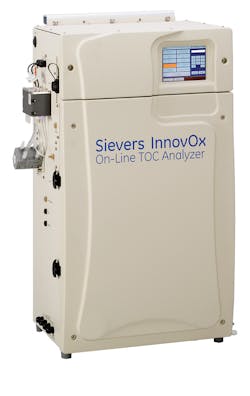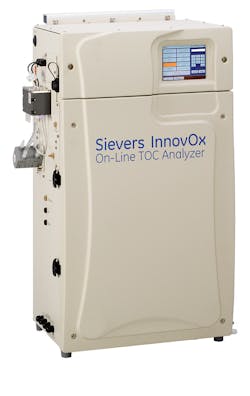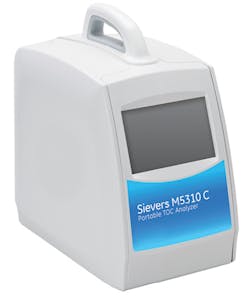Gaining Insight with Real-Time TOC Monitoring
Improve control, quality, and compliance by adding total organic carbon to your organics monitoring regime
By Céline Assmann and Amanda Scott
Operating decisions regarding water and wastewater treatment depend on an accurate assessment of organic pollution using organics measurement tools such as biological oxygen demand (BOD), chemical oxygen demand (COD), and total organic carbon (TOC). To comply with regulations and optimize treatment steps to save time and money, knowing and understanding organics loading and organic removal efficiencies are extremely valuable as critical control tools.
BOD and COD are traditional, laboratory-based parameters for organic content measurements while TOC is a relative newcomer. Though these tests measure different things in water, there is overlap in the results, and they provide information about the relative organic “strength” of water and wastewater samples. BOD and COD comprise the U.S. and European regulatory framework and are largely required to prove compliance with effluent limitations. Adding TOC data as a complement can quickly uncover opportunities to adjust processes to optimize operations. These opportunities would have been largely overlooked with COD or BOD information alone.
Online TOC analysis quantifies organic load variations with real-time data, allowing operators to make quick, data-driven treatment decisions based on observed fluctuations.
BOD and COD
BOD measures the amount of oxygen required for microbial degradation of organic contaminants in water. Results are known after five days of a sample’s incubation at 20°C with limited reproducibility (+/-20 percent) due to various factors such as interferences (presence of microbial inhibitors, sanitizers, chlorine, salts, etc.) and operator practices.
COD is a popular alternative and complementary test to BOD, with its major advantage being that it takes only two hours to complete. COD measures the amount of oxygen required for the chemical oxidation of compounds in water. The test uses hazardous and toxic chemicals, such as potassium dichromate in a 50 percent sulfuric acid solution, and interferes with chloride, nitrite, and ferrous ions.
While BOD and COD are necessary, their challenges are considered undesirable. Alternative ways to measure organic strength are always being sought out.
TOC
In a field where short-term adjustments and instant results are critical, TOC monitoring is a testing method that more and more water and wastewater plant operators are adding to their organics monitoring regime. Unlike BOD and COD, TOC can be performed in a laboratory and/or online, with results generated every few minutes.
TOC analyzers measure the gross amount of organic matter found in a water or wastewater sample. There are different types of analyzers but all oxidize organic carbon into carbon dioxide (CO2) then measure the CO2 generated using a detection method. Oxidation methods include combustion, ultraviolet (UV) persulfate, and super-critical water oxidation while detection methods include non-dispersive infrared (NDIR) and membrane conductivity.
The major benefit of online analysis is that it quantifies organic load variations with real-time data. This allows operators to make quick, data-driven treatment decisions based on observed fluctuations, saving both time and money.
Online TOC analyzers typically require maintenance throughout the year and have consumable parts that need replacing. Newer TOC analyzers, however, are designed for ease of use, requiring maintenance just once per quarter and calibration every six to twelve months.
Perhaps one of the biggest considerations for TOC is sensitivity to accurately detect process changes and precisely quantify both low and high amounts of organic contamination.
Case in Point
Outlined below are three municipal drinking water and wastewater treatment plants in the U.S. that have implemented online TOC monitoring as a tool to make informed and rapid treatment decisions. TOC analysis has helped these operators optimize plant processes and operations.
City of Boulder Public Works Wastewater Treatment Facility, Colorado
In 2008, the 75th Street Wastewater Treatment Facility (WWTF) upgraded its biological nutrient removal process to a modified Ludzack-Ettinger (MLE). The activated sludge process successfully reduced effluent ammonia and nitrate concentrations to below compliance levels until new daily maximum limits were implemented in 2017. At risk of violation, the WWTF completed on-site testing and process modeling to determine the cause of incomplete denitrification: carbon limitation in the anoxic zones of the WWTF’s MLE process.
The use of data from a Sievers* InnovOx Online TOC Analyzer allowed the City of Boulder to demonstrate that the diurnal patterns of carbon and nitrogen were offset enough to contribute to the WWTF’s carbon limitation. This presented a host of optimization opportunities that had been overlooked since the carbon/nitrogen ratios were previously considered on a daily basis. With this information, the city settled on a nitrogen upgrade to mitigate the issue. The nitrogen solution will enable operations staff to reduce external carbon use by equalizing the diurnal fluctuation of the carbon/nitrogen ratio. It will also support the plant’s goal of meeting new regulations for nutrient effluent rejects.
The online TOC analyzer used at the Colorado plant features robust sample handling capability and patented supercritical water oxidation technology. Its 2-stream or optional 5-stream configuration allows for continuous monitoring of multiple effluent sources while configurations for varying amounts of particle content — without the maintenance of filtering systems — make it ideal for wastewater applications.
Twin Oaks Valley Water Treatment Plant, San Marcos, California
This zero-discharge, submerged membrane ultrafiltration (UF) water treatment plant uses 95 percent surface water and 5 percent reclaimed water (primarily backwash from the UF membrane trains) as its source water. The process of recycling water on-site starts with equalization followed by the addition of coagulant/flocculant, and then settling in Lamella+ plate settlers. The settled water is combined with the raw water and fed to the UF membranes. The plant implemented TOC monitoring on the influent and effluent to the plate settlers to understand the organics removal efficiency from plate settlers. They also wanted to understand UF membrane organic fouling potential so they could adjust treatment to prevent it from occurring.
Online analysis using a Sievers InnovOx Online TOC Analyzer showed an initial TOC removal efficiency of about 40 to 50 percent. While trying different chemical treatment options, online TOC analysis provided near real-time insight into the efficiency of the treatment. In this case, controlling the pH provided better TOC removal efficiency than adding a different coagulant, but ensuring the appropriate balance requires continuous and proper monitoring of organic removal. The plant has maintained TOC monitoring to ensure optimal operation and continues to test new technologies that improve organics removal to prevent membrane fouling.
TOC analysis supports compliance with DBP rules through automatic calculations of TOC percentage removal for influent and effluent streams or samples.
City of Englewood Water Treatment Plant, Colorado
This drinking water treatment plant treats surface water from a local river. To conduct process improvement and find cost-savings opportunities, the city expanded its process data for jar testing from just turbidity to include TOC. Before conducting any trials, they were dosing chemicals blindly to ensure compliance with disinfection by-product (DBP) regulations, which require both TOC removal and minimizing formation of DBPs at the furthest point in their distribution system.
The city implemented TOC monitoring with a Sievers M5310 C TOC Analyzer. Specifically designed for drinking water applications, the analyzer supports compliance with DBP rules through automatic calculations of TOC percentage removal for influent and effluent streams or samples. The system is pre-calibrated, self-contained with a small footprint, and requires minimal maintenance. The analyzer at City of Englewood Water Treatment Plant is portable and allows for grab samples without removing the instrument from the continuous sample source or changing the sample inlet configuration.
By implementing TOC, the city reduced operational cost expenditures within several steps of plant optimization. These included the ability to: change pH, change coagulant type or coagulant dosage to obtain optimum results, ensure removal of organics, and know when to regenerate granular activated carbon (GAC).
Conclusion
TOC monitoring drives smart, informative, and rapid decision-making to improve process control of drinking water and wastewater treatment plants. Implementing TOC analysis at water treatment facilities is a powerful tool that can help operators continue to effectively treat water and positively impact the costs of treatment to meet current and future regulatory requirements.
About the Authors: Céline Assmann, industrial and environmental product applications specialist for the Sievers Instruments product line of SUEZ Water Technologies & Solutions, is responsible for the development and deployment of organics monitoring solutions for industrial and environmental markets in Europe.
Amanda Scott, industrial and environmental product and applications manager for the Sievers Instruments product line of SUEZ Water Technologies & Solutions, offers global application support and product development of analytical instruments for industrial and environmental markets.
*A trademark of SUEZ, may be registered in one or more countries
+A trademark of Parkson Corporation
Circle No. 238 on Reader Service Card


